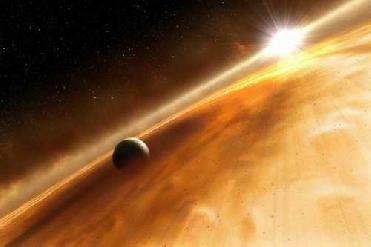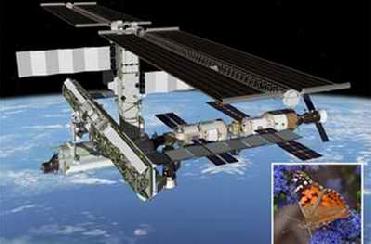
Artist's concept of the star Fomalhaut and the Jupiter-type planet that the Hubble Space Telescope observed. Credit: ESA, NASA, and L Calcada (ESO for STScI)
WASHINGTON (BNS): For the first time NASA�s Hubble Space Telescope has taken the first visible-light snapshot of a planet circling another star. According to NASA it is estimated to be no more than three times Jupiter's mass, the planet, called Fomalhaut b, orbits the bright southern star Fomalhaut, located 25 light-years away in the constellation Piscis Australis, or the �Southern Fish�.
Ever since, NASA's Infrared Astronomy Satellite, IRAS, discovered an excess of dust (a telltale sign of planet formation) around the star, during the 1980s, Fomalhaut has been a candidate for planet hunting.
NASA said that in 2004, the coronagraph in the High Resolution Camera on Hubble's Advanced Camera for Surveys produced the first-ever resolved visible-light image of the region around Fomalhaut. It may be recalled that a coronagraph is a device that can block the bright light of a central star to reveal faint objects around it. NASA said that the image clearly showed a ring of proto-planetary debris approximately 21.5 billion miles across and having a sharp inner edge.
This large debris disk is similar to the Kuiper Belt, which encircles the solar system and contains a range of icy bodies from dust grains to objects the size of dwarf planets, such as Pluto, scientists as NASA said.
In 2005, Hubble astronomer Paul Kalas, of the University of California at Berkeley, and team members proposed that the ring was being gravitationally modified or �shepherded� by a planet lying between the star and the ring�s inner edge. Now, Hubble has actually photographed a point source of light lying 1.8 billion miles inside the ring's inner edge. The results of the study are appearing in the November 14 issue of Science magazine.
�Our Hubble observations were incredibly demanding. Fomalhaut b is 1 billion times fainter than the star. We began this programme in 2001, and our persistence finally paid off,� Kalas says.
Studies conducted within a gap of 21 months by Hubble's Advanced Camera for Surveys' coronagraph show that the object is moving along a path around the star, and is therefore gravitationally bound to it. The planet is 10.7 billion miles from the star, or about 10 times the distance of the planet Saturn from our sun, NASA said.
The scientists were of the opinion that the planet is brighter than expected for an object of three Jupiter masses. One possibility is that it has a Saturn-like ring of ice and dust reflecting starlight. The ring might eventually coalesce to form moons. The ring's estimated size is comparable to the region around Jupiter and its four largest orbiting satellites, they said.
Kalas and his team first used Hubble to photograph Fomalhaut in 2004, and made the unexpected discovery of its debris disk. At that time, they noted a few bright sources in the image as planet candidates. A follow-up image in 2006 showed that one of the objects had changed position since the 2004 exposure. The amount of displacement between the two exposures corresponds to an 872-year-long orbit as calculated from Kepler's laws of planetary motion.
Future observations will attempt to see the planet in infrared light and will look for evidence of water vapour clouds in the atmosphere. This would yield clues to the evolution of a comparatively newborn 100-million-year-old planet. Astrometric measurements of the planet's orbit will provide enough precision to yield an accurate mass.
It is believed that NASA's James Webb Space Telescope, scheduled to launch in 2013 will be able to make coronagraphic observations of Fomalhaut in the near- and mid-infrared. �Webb will be able to hunt for other planets in the system and probe the region interior to the dust ring for structures such as an inner asteroid belt,� NASA said.
 Previous Article
Previous Article Next Article
Next Article













The Indian Air Force, in its flight trials evaluation report submitted before the Defence Ministry l..
view articleAn insight into the Medium Multi-Role Combat Aircraft competition...
view articleSky enthusiasts can now spot the International Space Station (ISS) commanded by Indian-American astr..
view article